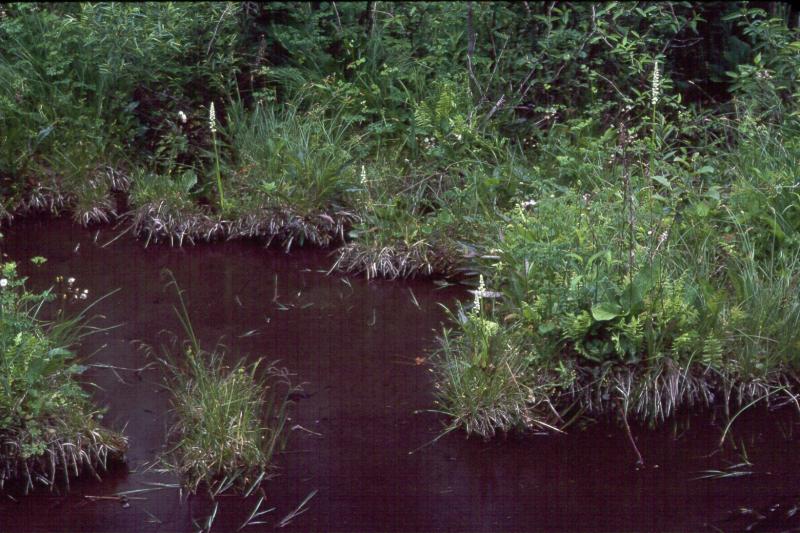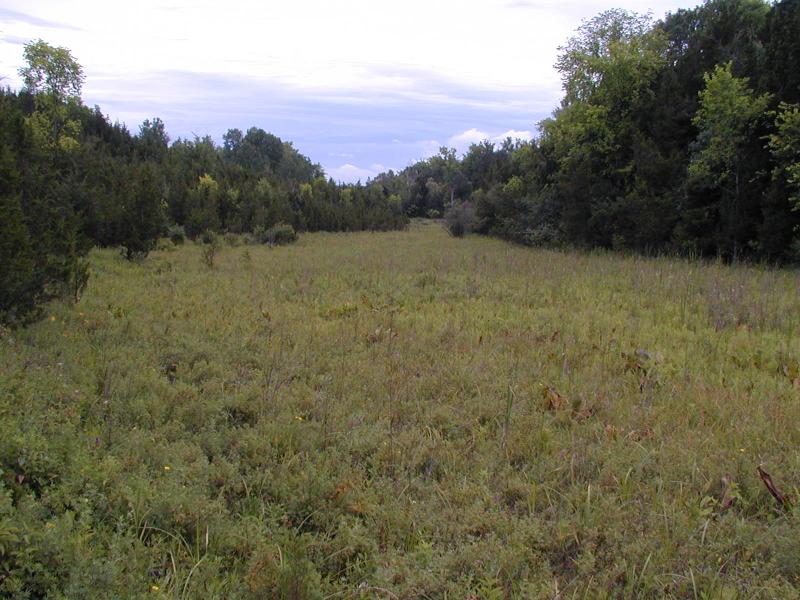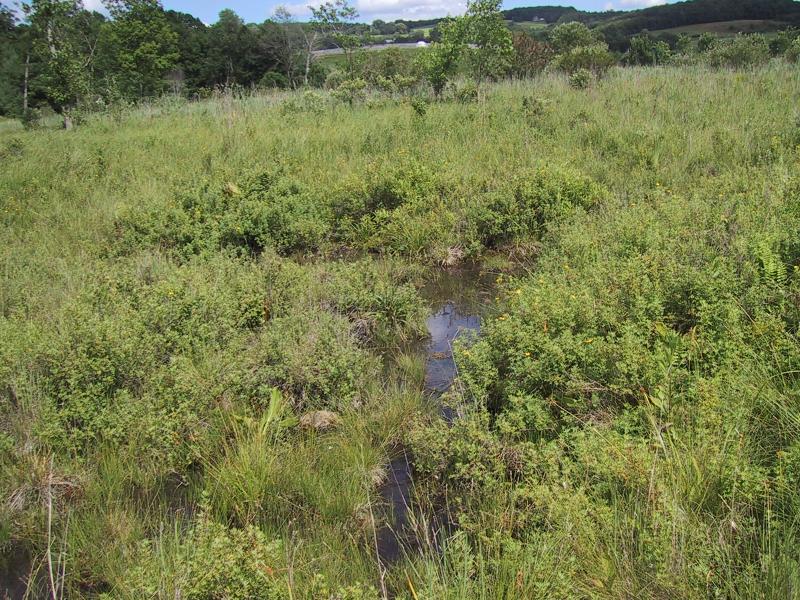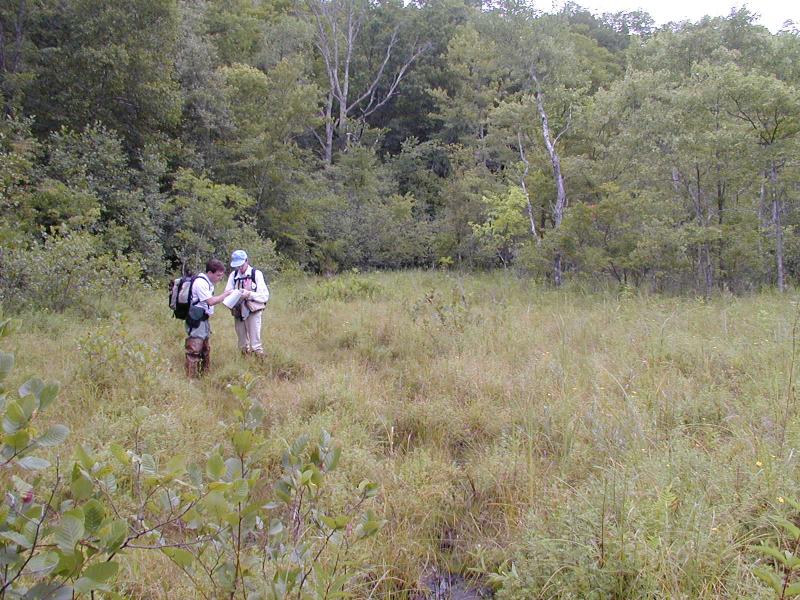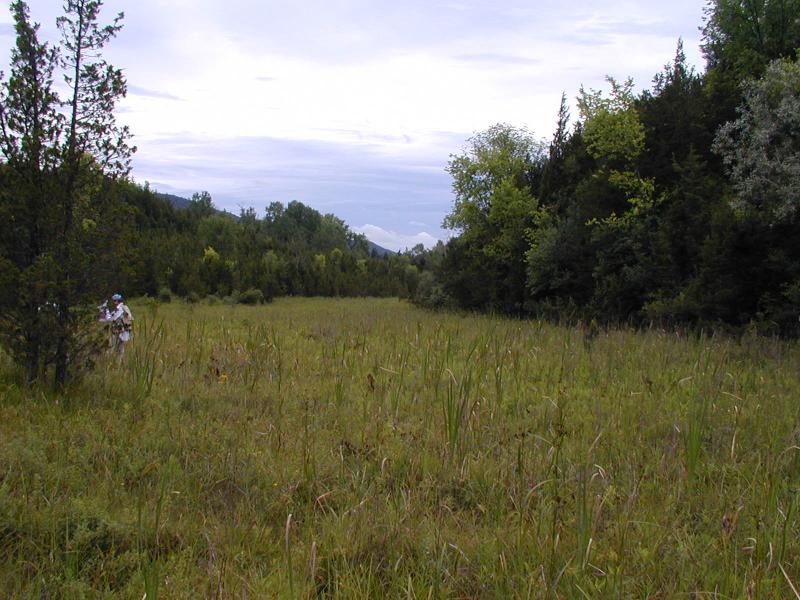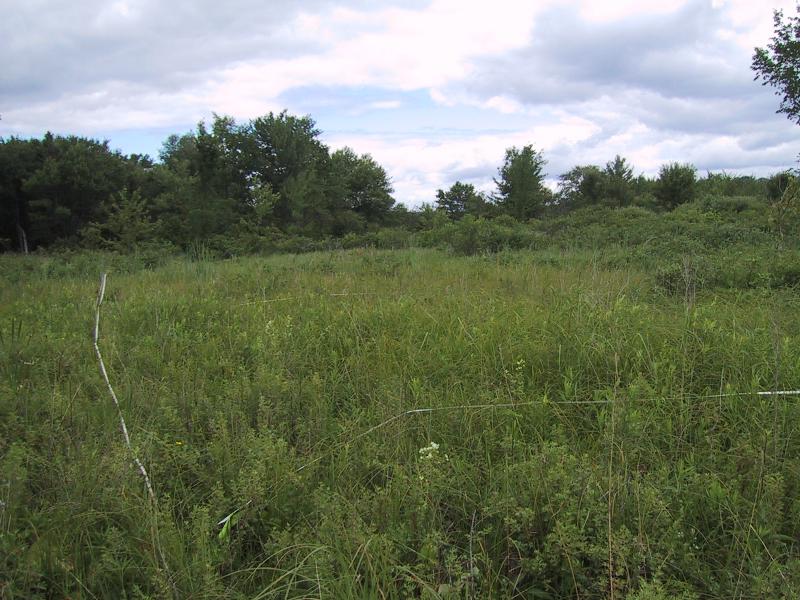Rich Sloping Fen
- System
- Palustrine
- Subsystem
- Open Peatlands
- State Protection
- Not Listed
Not listed or protected by New York State.
- Federal Protection
- Not Listed
- State Conservation Status Rank
- S1?
Critically Imperiled in New York (most likely) - Conservation status is uncertain, but most likely especially vulnerable to disappearing from New York due to extreme rarity or other factors; typically 5 or fewer populations or locations in New York, very few individuals, very restricted range, very few remaining acres (or miles of stream), and/or very steep declines. More information is needed to assign a firm conservation status.
- Global Conservation Status Rank
- G3
Vulnerable globally - At moderate risk of extinction due to rarity or other factors; typically 80 or fewer populations or locations in the world, few individuals, restricted range, few remaining acres (or miles of stream), and/or recent and widespread declines.
Summary
Did you know?
Fens influenced by calcareous bedrock can harbor an interesting group of green algae. Stoneworts (such as Chara vulgaris), are highly evolved algae that are often mistaken for vascular plants. They appear to have stems and branches, and are similar in appearance to submerged aquatic plants such as milfoil (Myriophyllum spp.), but they lack the internal water and nutrient transport structures common to all vascular plants. Stoneworts are thought to be closely related to non-vascular plants (mosses and liverworts), because the two groups have many evolutionary cytological and biochemical homologies.
State Ranking Justification
There are less than one hundred occurrences statewide. Some documented occurrences have good viability and several are protected on public land or private conservation land. This community is limited to the calcareous areas of the state and is restricted to wetlands that gain most of their moisture from underground sources that flow through calcareous substrates. There are few high quality examples. Most sites are small and some are very disturbed. The current trend of this community is probably stable for occurrences on public land, or declining slightly elsewhere due to moderate threats related to development pressure or alteration to the natural hydrology. Total acreage is very limited and many sites are too small to be protected by New York State freshwater wetland regulations.
Short-term Trends
The number and acres of rich sloping fens in New York have probably stabilized in recent decades as a result of wetland protection regulations.
Long-term Trends
The number acreage of rich sloping fens in New York probably declined moderately to substantially from their historical numbers likely correlated with the onset of agricultural and residential development.
Conservation and Management
Threats
Rich sloping fens are threatened by development and its associated run-off (e.g., agriculture, residential, roads) and habitat alteration in the adjacent landscape (e.g., clearing, logging, mowing, pollution, dumping, mining, utility ROWs). Alteration to the natural hydrology is also a threat to this community (e.g., ditching, blocked culverts, beaver). Nearly all examples of rich sloping fen are threatened by invasive species, such as purple loosestrife (Lythrum salicaria), reed grass (Phragmites australis ssp. australis), and dozens of non-native plants typical of successional old fields and pastures.
Conservation Strategies and Management Practices
Consider how water flows around and into this wetland. As most of the water inputs are from underground, management for the prevention of altered water quality and quantity is particularly difficult for this natural community, but also should be of utmost priority. Projects that occur near this community must consider the proximity of the development to this wetland and the potential for changing how water flows, both aboveground and belowground, into this wetland. Terrestrial buffers provide nesting habitat for resident salamanders, frogs, and turtles, and additional food sources for locally nesting birds, and thus they should be retained. Consultation with a hydrologist is important to determine patterns of run-off and underground water sources for the wetland; the construction of impervious surfaces, which rapidly deliver water to the wetland, should be avoided. Rapid influxes of surface water dilute the limey, mineral rich waters, decrease the robustness of the native fen species, and increase the likelihood of invasion by non-native species.
Development and Mitigation Considerations
Avoid or minimize the disruption of the groundwater hydrology in and around rich sloping fens. The presence of seeps and small streams within these fens means that typically the ground is saturated year-round and often does not freeze solid, making them very sensitive to compaction even in winter. New or modified inputs of surface water may modify the chemical composition of the substrate within the fen and the water feeding it. A change in chemistry in the fen may favor the increase of non-native invasive species over the persistence of alkaline-loving native fen species.
Inventory Needs
Additional inventory efforts in regions with calcareous bedrock and promising wetlands will likely turn up a few additional sites. Re-inventories of known sites will provide important information to help assess short- and long-term changes. Survey fens that provide habitat for rare species. For example, extant bog turtle sites should be surveyed to determine the type and quality of the natural community if it is unknown.
Research Needs
Research better ways to accurately and efficiently measure and understand the groundwater hydrology of fens. Further research into determining the proportion of fen water inputs is needed (e.g., groundwater vs. surface). If a fen is strongly groundwater influenced, traditional wetland buffers aimed at reducing surface water run-off may not sufficiently protect the fen hydrology.
Rare Species
- Calephelis borealis (Northern Metalmark) (guide)
- Carex buxbaumii (Brown Bog Sedge) (guide)
- Carex capillaris (Hair-like Sedge) (guide)
- Carex emoryi (Emory's Sedge) (guide)
- Carex garberi (Elk Sedge) (guide)
- Carex livida (Livid Sedge) (guide)
- Carex meadii (Mead's Sedge) (guide)
- Carex sartwellii (Sartwell's Sedge) (guide)
- Carex schweinitzii (Schweinitz's Sedge) (guide)
- Chamaelirium luteum (Fairywand) (guide)
- Cirriphyllum piliferum (Hair-pointed Moss) (guide)
- Cistothorus stellaris (Sedge Wren) (guide)
- Cypripedium candidum (Small White Lady's Slipper) (guide)
- Gentianopsis virgata (Lesser Fringed Gentian) (guide)
- Glyptemys muhlenbergii (Bog Turtle) (guide)
- Juniperus horizontalis (Creeping Juniper) (guide)
- Poa paludigena (Slender Marsh Blue Grass) (guide)
- Pseudocalliergon turgescens (Curving Feather Moss) (guide)
- Pycnanthemum verticillatum var. verticillatum (Whorled Mountain Mint) (guide)
- Solidago ohioensis (Ohio Goldenrod) (guide)
- Tachopteryx thoreyi (Gray Petaltail) (guide)
- Triglochin palustris (Marsh Arrow Grass) (guide)
- Trollius laxus (Spreading Globeflower) (guide)
- Viola nephrophylla (Northern Bog Violet) (guide)
Range
New York State Distribution
Extant sites cluster into three large elliptical shaped areas: 1) eastern New York centered around Dutchess and Putnam counties, 2) central New York centered around Tompkins and Cortland counties, and 3) western New York centered around Wyoming County. The historical range is unknown, but this community probably occurred all across upstate New York south of the Adirondacks.
Global Distribution
This physically broadly-defined community may be widespread in areas of the United States and worldwide with calcareous seepage. Examples with the greatest biotic affinities to New York occurrences are suspected to extend north into Ontario, south to the central Appalachians of North Carolina and Tennessee, west to Wisconsin, Illinois and Iowa, east to western New England, and northeast to New Brunswick. Few examples are suspected east of the Appalachian Divide, where the bedrock is mostly acidic.
Best Places to See
- Letchworth State Park (Livingston, Wyoming Counties)
- Tioughnioga Wildlife Management Area (Madison County)
- Malloryville Swamp Preserve (Tompkins County)
- Black Creek Bog Preserve, Adirondack Park (Herkimer County)
Identification Comments
General Description
A small, gently sloping, minerotrophic wetland, with shallow peat deposits (usually at least 20 cm), that occurs in a shallow depression on a slope (1° or greater) composed of calcareous glacial deposits. Sloping fens are fed by small springs or groundwater seepage. Like other rich fens, their water sources have high concentrations of minerals and high pH values, generally from 6.0 to 7.8. Rich sloping fens are headwater wetlands with cold water constantly moving through them. They often have water flowing at the surface in small channels or rivulets. Rich sloping fens are often surrounded by upland forest and grade into other palustrine communities such as hemlock-hardwood swamp, shrub swamp, or shallow emergent marsh downslope. This community shares many species with other rich fens, but can be separated by having a measurable slope (e.g., 1° to >5°) and its position in the landscape. The structure of rich sloping fens is variable; usually there are scattered trees and shrubs and a nearly continuous groundlayer of herbs and bryophytes. They may be shrub-dominated or herb-dominated. Species diversity is usually very high and may include species from the surrounding forest.
Characters Most Useful for Identification
Characteristic shrubs and small trees include red osier dogwood (Cornus sericea), willows (Salix discolor, S. sericea, S. bebbiana) dwarf raspberry (Rubus pubescens), northern gooseberry (Ribes hirtellum), alder-leaf buckthorn (Rhamnus alnifolia), arrowwood (Viburnum dentatum var. lucidum), highbush blueberry (Vaccinium corymbosum), red maple (Acer rubrum), eastern red cedar (Juniperus virginiana), and eastern hemlock (Tsuga canadensis). Characteristic herbs include skunk-cabbage (Symplocarpus foetidus), marsh fern (Thelypteris palustris), spotted joe-pye-weed (Eutrochium maculatum), spreading goldenrod (Solidago patula), sedges (Carex leptalea, C. flava, C. hystericina, C. interior, C. sterilis, C. stricta), golden ragwort (Packera aurea), purple-stemmed aster (Symphyotrichum puniceum var. puniceum), cat-tails (Typha latifolia and T. angustifolia), swamp goldenrod (Solidago uliginosa), cotton-grass (Eriophorum viridi-carinatum), boneset (Eupatorium perfoliatum), flat-topped white aster (Doellingeria umbellata var. umbellata), purple avens (Geum rivale), tall meadow-rue (Thalictrum pubescens), common horsetail (Equisetum arvense), fowl mannagrass (Glyceria striata), field mint (Mentha arvensis), sundew (Drosera rotundifolia), water-horehound (Lycopus americanus), cinnamon fern (Osmunda cinnamomea), bulrush (Scirpus atrovirens), wild strawberry (Fragaria virginiana), water-horehound (Lycopus uniflorus), and grass-leaved goldenrod (Euthamia graminifolia). Characteric bryophytes include the mosses Calliergonella lindbergii, Hamatocaulis vernicosus, Helodium blandowii, Philonotis fontana, several peat mosses (Sphagnum centrale, S. fimbriatum, S. teres), and the thalloid liverwort Marchantia polymorpha. Mosses that can become characteristically abundant in rich sloping fens include Calliergonella cuspidata, Cratoneuron filicinum, the peat moss Sphagnum warnstorfii, and the rare golden moss (Tomentypnum nitens). Additional rich sloping fen bryophytes common to other rich fen types include the mosses Aulacomnium palustre, Bryum pseudotriquetrum, Calliergonella lindbergii, Campylium stellatum, Fissidens adianthoides, Scorpidium revolvens and the thalloid liverwort Aneura pinguis. Odonates, such as the brush-tipped emerald (Somatochlora walshii) and clamp-tipped emerald (Somatochlora tenebrosa), are characteristic of some rich sloping fens.
Elevation Range
Known examples of this community have been found at elevations between 116 feet and 1,760 feet.
Best Time to See
One of the best times to visit this community is when the showy yellow flowers of shrubby cinquefoil are in full bloom, usually from mid July to mid August. Rich sloping fens are also scenic during late summer, when plant species of the aster family come into bloom.
Rich Sloping Fen Images
Classification
International Vegetation Classification Associations
This New York natural community encompasses all or part of the concept of the following International Vegetation Classification (IVC) natural community associations. These are often described at finer resolution than New York's natural communities. The IVC is developed and maintained by NatureServe.
- (Inland Sedge, Bottlebrush Sedge, Yellow Sedge) - Alpine Bulrush / Star Campylium Moss Fen (CEGL006331)
- Gray Dogwood / (Dioecious Sedge, Water Sedge, Lake Sedge) Fen (CEGL006123)
- Red-osier Dogwood - Silky Dogwood - Black Chokeberry - Nannyberry Fen (CEGL005088)
- Shrubby-cinquefoil / Inland Sedge - Yellow Sedge - Fen Grass-of-Parnassus Fen (CEGL005140)
- Shrubby-cinquefoil / (Dioecious Sedge, Bottlebrush Sedge, Yellow Sedge) Fen (CEGL006326)
NatureServe Ecological Systems
This New York natural community falls into the following ecological system(s). Ecological systems are often described at a coarser resolution than New York's natural communities and tend to represent clusters of associations found in similar environments. The ecological systems project is developed and maintained by NatureServe.
- Laurentian-Acadian Alkaline Fen (CES201.585)
- North-Central Appalachian Seepage Fen (CES202.607)
Characteristic Species
-
Trees > 5m
- Acer rubrum var. rubrum (common red maple)
- Juniperus virginiana var. virginiana (eastern red cedar)
-
Shrubs 2 - 5m
- Fraxinus nigra (black ash)
- Toxicodendron vernix (poison-sumac)
-
Shrubs < 2m
- Cornus sericea (red-osier dogwood)
- Dasiphora fruticosa (shrubby-cinquefoil)
- Rhamnus alnifolia (alder-leaved buckthorn)
- Ribes hirtellum (northern gooseberry)
- Salix discolor (pussy willow)
-
Vines
- Clematis virginiana (virgin's-bower)
-
Herbs
- Carex flava (yellow sedge)
- Carex hystericina (porcupine sedge)
- Carex lacustris (lake-bank sedge)
- Carex leptalea (bristle-stalked sedge)
- Carex sterilis (dioecious sedge)
- Carex stricta (tussock sedge)
- Drosera rotundifolia (round-leaved sundew)
- Eriophorum viridicarinatum (green-keeled cotton-grass)
- Eupatorium perfoliatum (boneset)
- Eutrochium maculatum var. maculatum (spotted Joe-Pye-weed)
- Lycopus americanus (American bugleweed, American water-horehound)
- Muhlenbergia glomerata (spike muhly)
- Scirpus atrovirens (dark-green bulrush)
- Solidago patula (rough-leaved goldenrod)
- Symphyotrichum puniceum var. puniceum (purple-stemmed-aster)
- Symplocarpus foetidus (skunk-cabbage)
- Thelypteris palustris var. pubescens (marsh fern)
- Typha latifolia (wide-leaved cat-tail)
-
Nonvascular plants
- Calliergonella cuspidata
- Campylium stellatum
- Sphagnum warnstorfii
-
Submerged aquatics
- Chara vulgaris
Similar Ecological Communities
- Rich graminoid fen
(guide)
Rich graminoid fens are open wetlands with less than 50% shrub cover, which occur on strongly mineral enriched peat soils, with bedrock generally at a depth of 90 cm or greater from the surface. They are situated in basins or at sites with less than one degree slope, often adjacent to a river, pond, or lake. Standing surface water may be present but it is not flowing in small channels or rivulets.
- Rich shrub fen
(guide)
Rich shrub fens are open wetlands with greater than 50% shrub cover, which occur on strongly mineral enriched peat soils, with bedrock generally at a depth of 90 cm or greater from the surface. They are situated in basins or low lying areas with less than one degree slope, often adjacent to a river, pond, or lake. Standing surface water may be present but it is not flowing in small channels or rivulets.
Vegetation
Percent cover
This figure helps visualize the structure and "look" or "feel" of a typical Rich Sloping Fen. Each bar represents the amount of "coverage" for all the species growing at that height. Because layers overlap (shrubs may grow under trees, for example), the shaded regions can add up to more than 100%.
Additional Resources
References
Cowardin, L.M., V. Carter, F.C. Golet, and E.T. La Roe. 1979. Classification of wetlands and deepwater habitats of the United States. U.S. Fish and Wildlife Service. Washington, D.C. 131 pp.
Edinger, G. J., D. J. Evans, S. Gebauer, T. G. Howard, D. M. Hunt, and A. M. Olivero (editors). 2014. Ecological Communities of New York State. Second Edition. A revised and expanded edition of Carol Reschke’s Ecological Communities of New York State. New York Natural Heritage Program, New York State Department of Environmental Conservation, Albany, NY. https://www.nynhp.org/ecological-communities/
Godwin, K.S., J.P. Shallenberger, D.J. Leopold, and B.L. Beford. 2000. Linking landscape parameters to local hydrogeologic gradients and plant species occurrence in New York fens: A hydrogeologic setting (HGS) framework. Unpublished draft manuscript. December 20, 2000.
Motzkin, G. 1994. Calcareous fens of western New England and adjacent New York State. Rhodora. 96(885): 44-68.
New York Natural Heritage Program. 2024. New York Natural Heritage Program Databases. Albany, NY.
New York State Department of Environmental Conservation. 1995. Freshwater Wetlands: Delineation Manual. July 1995. New York State Department of Environmental Conservation. Division of Fish, Wildlife, and Marine Resources. Bureau of Habitat. Albany, NY.
Olivero, Adele M. 2001. Classification and Mapping of New York's Calcareous Fen Communities. A summary report prepared for the Nature Conservancy - Central/Western New York Chapter with funding from the Biodiversity Research Institute. New York Natural Heritage Program, New York State Department of Environmental Conservation. Albany, NY. 28 pp. plus nine appendices.
Olivero, Adele. 2002. Survey of Eastern New York's calcareous fens in the Mount Everett-Mount Riga landscape. A report prepared for the Nature Conservancy Eastern New York Chapter. New York Natural Heritage Program, New York State Department of Environmental Conservation. Albany, NY. 31 pp. plus appendices.
Reschke, Carol, B. Bedford, N. Slack, and F.R. Wesley. 1990. Fen Vegetation of New York State. A poster presented of July 31, 1990 at the Ecological Society of America Annual Meeting, Snowbird, Utah.
Reschke, Carol. 1990. Ecological communities of New York State. New York Natural Heritage Program, New York State Department of Environmental Conservation. Latham, NY. 96 pp. plus xi.
Slack, Nancy G. 1994. Can one tell the mire type from the bryophytes alone? J. Hattori Bot. Lab 75:149-159.
Links
About This Guide
This guide was authored by: Aissa Feldmann
Information for this guide was last updated on: November 13, 2023
Please cite this page as:
New York Natural Heritage Program. 2024.
Online Conservation Guide for
Rich sloping fen.
Available from: https://guides.nynhp.org/rich-sloping-fen/.
Accessed July 26, 2024.
